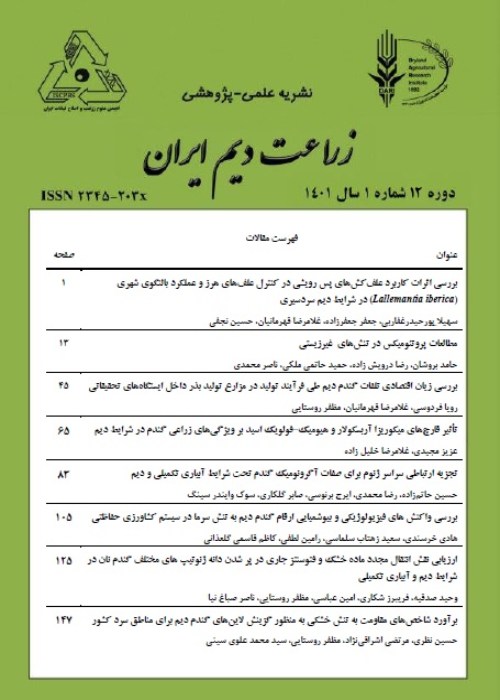Evaluation of biochemical and physiological changes of safflower (Carthamus tinctorius L.) with the application of zinc and iron nanoparticles under different moisture conditions
A considerable fraction of the decline in quality and quantity of crop production in the arable land is attributed to drought stress and deficiency of trace elements, especially zinc and iron. To investigate the effect of foliar application of zinc and iron nanoparticles in low irrigation conditions on biochemical and physiological traits of safflower (Sina cultivar), an experiment was conducted in the form of split plots based on a randomized complete block with three replications in 2016 at Maragheh University. Different irrigation levels (90, 75, and 50% of field capacity) as the main factors and the application of zinc and iron nanoparticles (Non-application of nanoparticles, 30 and 60 mM Nano-Iron, 30 and 60 mM Nano-Zinc) as the sub-factors were considered. According to the results of the analysis of variance, the simple effects of low irrigation treatment and application of nanoparticles and their interaction were significant for most of the studied traits. The highest amount of indole acetic acid with 454.7 and the highest amount of cytokinin with 355.7 ng/gFW were recorded in 60 mM nano zinc application at irrigation in 90% field capacity. The highest levels of gibberellin with 146.6 and 154.8 ng/gFW were observed in 60 mM nano zinc application at irrigation in 90% field capacity, respectively. The highest amount of grain protein with 24.11% was obtained in non-foliar treatment under irrigation of 50% of field capacity. Also, the highest yield of safflower with 1366 kg/ha was observed in the application of 60 mM nano-zinc with irrigation at 90% of field capacity. According to the results of this study, the application of 60 mM of nano-zinc was able to improve the growth and yield of safflower under stress, which shows the undeniable role of zinc in increasing the resistance of crops to environmental stresses.
- حق عضویت دریافتی صرف حمایت از نشریات عضو و نگهداری، تکمیل و توسعه مگیران میشود.
- پرداخت حق اشتراک و دانلود مقالات اجازه بازنشر آن در سایر رسانههای چاپی و دیجیتال را به کاربر نمیدهد.


